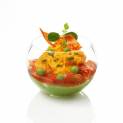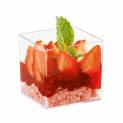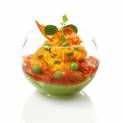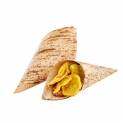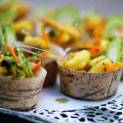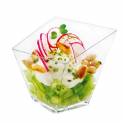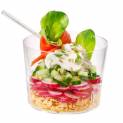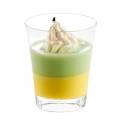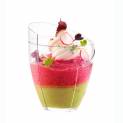
How Palm Leaf Plates and Bowls Are Crafted: A Simple Step-by-Step Guide
In recent years, eco-friendly products have become more popular, and one of the top choices for sustainable dining is palm leaf plates and bowls. These natural, biodegradable alternatives to plastic and paper tableware are a favorite among people and businesses who want to make environmentally conscious choices. But how are these plates and bowls made? In this blog, we’ll explain the simple, step-by-step process of creating palm leaf plates and bowls, and why they are a great option for your next meal or event.
What Are Palm Leaf Plates?
Palm leaf plates are eco-friendly tableware made from the naturally fallen leaves of the Areca palm tree. These plates are 100% natural, biodegradable, and free from harmful chemicals, offering a sustainable alternative to plastic or styrofoam. The leaves are collected, cleaned, and then pressed into shape to create durable, sturdy plates and bowls that can hold hot or cold food without leaking or breaking. Perfect for events, picnics, and restaurants, palm leaf plates offer a unique, rustic look and are compostable, making them a great choice for environmentally conscious consumers.
Step-by-Step Process
Step 1: Harvesting the Palm Leaves
The first step in making palm leaf plates is harvesting the leaves from the Areca palm tree. These trees are abundant in tropical regions, and the leaves used for making the plates are collected only after they naturally fall to the ground. This method ensures that the trees are not harmed, and no leaves are taken from living trees.
The leaves are usually collected by local farmers, and since the Areca palm is a renewable resource, this process doesn’t contribute to deforestation. The leaves are typically large and strong, making them ideal for creating durable, high-quality plates and bowls.
Step 2: Cleaning the Palm Leaves
Once the leaves are gathered, they are thoroughly cleaned to remove any dirt, debris, or dust. The cleaning process is done using water, often with the help of natural cleaning methods to ensure that no chemicals are introduced during this stage. The leaves are carefully washed by hand, ensuring that they are free from any contaminants and ready for further processing.
Step 3: Flattening and Softening the Leaves
After cleaning, the next step is to soften and flatten the palm leaves. This is done by placing the leaves under heat or steaming them to make them more pliable. The heat helps to soften the leaf fibers, making them easier to work with and mold into the desired shape. At this stage, the leaves are also dried to remove any excess moisture that could interfere with the molding process.
Step 4: Shaping the Plates and Bowls
Once the palm leaves are softened and dried, it’s time to start shaping them into plates and bowls. The leaves are carefully cut into specific sizes and then pressed into molds that shape them into the desired form. The molding process is done using pressure, which presses the palm leaf into the shape of a plate or bowl.
Depending on the design, different molds may be used to create round, square, or even more intricate shapes. The molds help to give each plate or bowl its final look while maintaining the natural texture and appearance of the palm leaf.
Step 5: Heat Pressing for Durability
After the palm leaves have been shaped into plates and bowls, they are heat-pressed once again to ensure that they maintain their form and strength. This additional heat treatment also helps to seal the fibers together, making the products more durable and resistant to breaking or cracking under pressure.
This process not only strengthens the plates but also enhances their natural texture, giving them a rustic, organic look. The final result is a sturdy, long-lasting product that can withstand hot foods and liquids without bending or leaking.
Step 6: Trimming and Polishing
After the plates and bowls have been pressed and formed, they go through a finishing stage. During this step, any excess edges or rough spots are trimmed off to give the plates a clean, smooth finish. Sometimes, the edges are slightly rounded or polished to create a more refined look.
At this stage, some manufacturers also apply a light polish or coating to enhance the appearance of the plates and bowls, making them look more vibrant and appealing. However, this step is optional and depends on the manufacturer’s preference. Many eco-friendly brands, like Sweet Flavor, choose to leave the products completely natural, preserving their rustic charm.
Step 7: Quality Control and Packaging
Once the palm leaf plates and bowls are shaped, pressed, and trimmed, they undergo a final quality check. Each product is inspected to ensure there are no cracks, flaws, or deformities. This ensures that only the best products make it to the customers.
After passing the quality control checks, the plates and bowls are neatly stacked, packed, and prepared for shipment. Palm leaf plates are lightweight, making them easy to store and transport without taking up much space.
Why Choose Palm Leaf Plates?
Now that you understand how palm leaf plates and bowls are made, it’s easy to see why they are such an attractive option for anyone looking to make eco-conscious choices. Here are a few reasons why palm leaf products are gaining popularity:
-
Sustainability: Palm leaves are a renewable resource. Since the plates are made from naturally fallen leaves, there’s no need to cut down any trees. The entire process is sustainable and eco-friendly.
-
Biodegradable: Palm leaf plates and bowls break down naturally over time, so they won’t contribute to the growing problem of plastic pollution.
-
Chemical-Free: Palm leaf plates are free from harmful chemicals and dyes, making them safe for both the environment and the people who use them.
-
Durability: Despite being made from natural materials, palm leaf plates are strong, sturdy, and able to hold up under hot or wet foods. They don’t leak, bend, or break easily.
-
Aesthetic Appeal: Each plate has a unique texture and appearance, giving them a rustic and natural charm that adds a special touch to any occasion.
Conclusion
In conclusion, the process of making palm leaf plates and bowls is a meticulous and eco-friendly method that starts with the sustainable harvesting of palm leaves and ends with the creation of durable, biodegradable tableware. Whether you’re hosting an event, running a business, or simply enjoying a meal at home, choosing palm leaf plates and bowls is a great way to reduce your environmental impact while adding a natural, elegant touch to your dining experience.
If you want to make the switch to eco-friendly dinnerware, check out the high-quality palm leaf plates and bowls available at Sweet Flavor. Their products are designed to bring sustainability and style to your table, one plate at a time.

